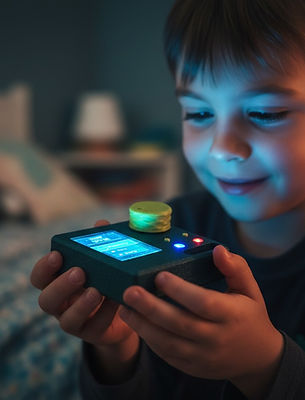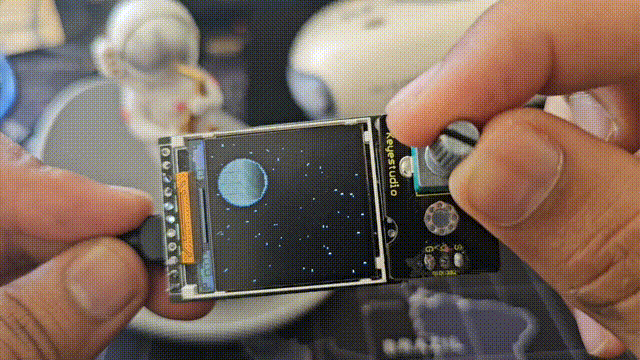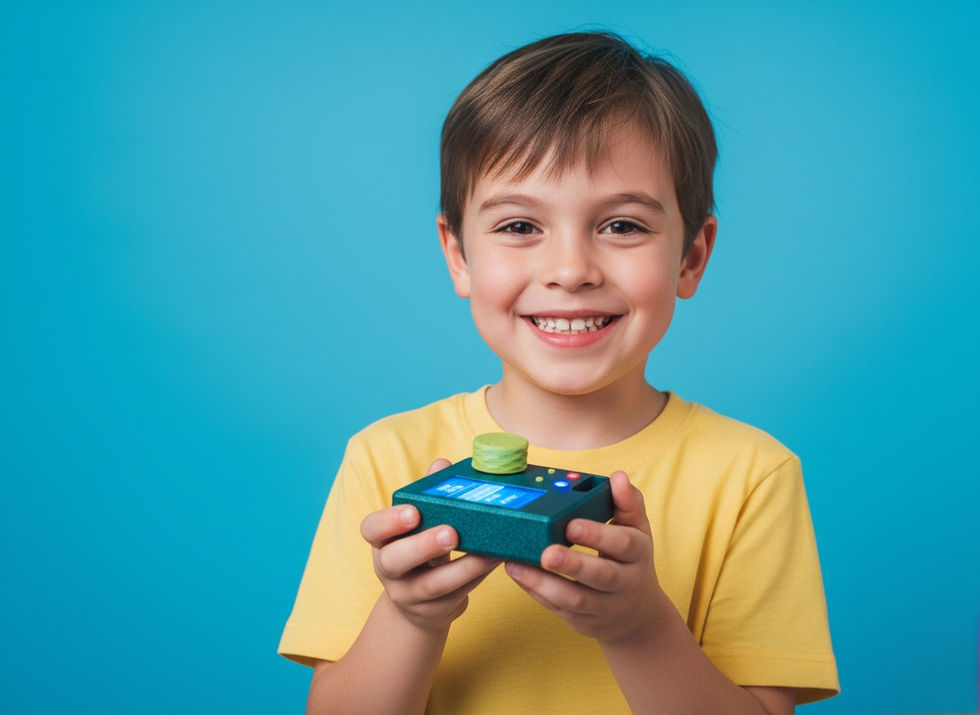Bring the Cosmos to your Fingertips.
Warp Drive is an open-source educational toy designed to ignite curiosity in the next generation of scientists and storytellers through tangible, interactive play.
.png)
Role
End-to-End Designer
Timeline
12 Weeks
Focus
Hardware + UX
Outcomes
4 prototypes
THE WHY
The Gap Between Passive Screens and Active Imagination
In a world saturated with tablets, a quiet challenge exists. Children are handed endless content but are rarely given the tools for focused discovery. For a young learner, this digital noise is the difference between fleeting entertainment and lasting curiosity. The challenge was not just to build an alternative to a tablet, but to design a tangible portal to the cosmos—one that could bridge the gap between passive screen time and active, hands-on exploration.

Process that Honors Play.
From a single visual effect to a multi-modal educational toy, every decision was driven by engagement, learning, and the simple joy of discovery.
Core Mechanic Ideation
20+ animation concepts were tested to create a fluid, tactile sense of speed controlled by a single knob, prototyping on an ESP32-S3 to push its graphical limits and ensure a flicker-free experience.
Synthesis
Affinity mapping of user feedback revealed a key insight: the journey needs a destination. This surfaced three design principles: discovery-as-reward, multisensory feedback, and layered learning modules (Quiz & Story modes).
Iterative Prototyping
Three major versions were developed. V1 established the visual engine. V2 layered in the Quiz and Story modes. V3 integrated haptics and LEDs, transforming the device into a fully immersive STEAM artifact.
.jpeg)
Turn screen time into learning experience

System map of Warp Drive
Key Insights.
What changed the trajectory from a visual effect to an educational universe.
INSIGHT 1
A cool effect isn't a toy.
The initial warp drive was visually engaging but lacked replayability. The breakthrough was realizing the journey was a hook; the randomized, animated discovery of a new planet or black hole was the reward that created a compelling play loop.
INSIGHT 2
Learning is doing, not just seeing.
Passive animations teach recognition, but interactive quizzes and guided stories build comprehension. Shifting from a "show" model to a "play and test" model transformed the device into an active learning tool that reinforces STEM concepts.
INSIGHT 3
Feedback must be multisensory.
Visuals alone are not enough for deep immersion. Integrating haptic vibrations that scale with warp speed and LED flashes for quiz results created an intuitive language that builds confidence without cognitive load.
Technology that Inspires
Cosmic Knobulator is an open-source universe that integrates seamlessly into a child's world of play. It's a fusion of core principles designed to empower, not overwhelm.
1. On-Device Intelligence
Real-time ECG analysis happens directly on the device, ensuring privacy and reliability without needing connectivity. Alerts are delivered via gentle, private vibrations.

All animations, physics, and game logic run directly on the ESP32-S3, leveraging its PSRAM for flicker-free graphics. This creates a self contained, distraction free experience with zero dependency on apps, Wi-Fi, or other devices ensuring the magic stays inside the box

The experience is driven by a physical potentiometer knob and button, providing nuanced, hands-on control that a touchscreen cannot replicate.

The software is built with a modular architecture and a clean state machine. Each celestial object, quiz, and story is a separate, self-contained component. This open-source design transforms the toy into an educational platform, empowering educators, makers, and kids to easily add new content, customize animations, or invent new game modes.

All animations, physics, and game logic run directly on the ESP32-S3, leveraging its PSRAM for flicker-free graphics. This creates a self contained, distraction free experience with zero dependency on apps, Wi-Fi, or other devices ensuring the magic stays inside the box

V1: The Visual Engine
The beginning. A raw breadboard prototype focused on a single technical challenge: could a microcontroller render a smooth, high-frame-rate warp effect? It worked, but it was just code and wires.
V2: The Tactile Interface
A breakthrough. The physical knob and button were integrated, creating the core interaction loop. The feeling of twisting the knob to control cosmic speed was born. It was an effect, but it now felt like a tool.


V3: The Educational Core
The pivot. The software was re-architected into a state machine to support new modes. Quiz and Story modules were added, transforming the device from a physics visualizer into a true STEAM educational platform.
V4: The Artifact
The final form. Ergonomic, durable, and enclosed in a kid-safe 3D-printed shell. Technology finally disappeared, leaving only a tangible, magical portal to the stars.

Usability Learnings.
From Warp to Discovery
The "wow" of the warp effect hooks the user, but testing revealed the randomized discovery of 12+ unique celestial objects is what created long-term engagement and repeat play.
One Knob to Rule Them All
User testing with children quickly showed an intuitive preference for using the knob for all primary interactions—speed, selection, and scrolling. This simplified the control scheme to "turn to explore, press to confirm."
A Language Beyond Screens
The final UI—using light, haptic vibration, and simple on-screen text—was understood by kids across age groups, removing literacy or numeracy barriers to play and learning.
Hackability is a Feature
For educators and older kids, the open-source codebase became the most exciting feature. The ability to add new quiz questions, stories, or even celestial objects makes it a tool that grows with the user's skills.






